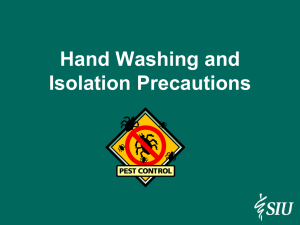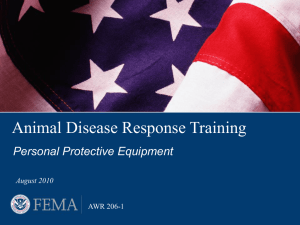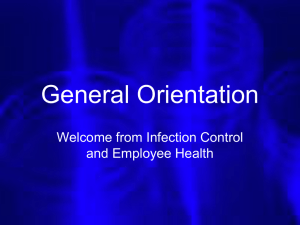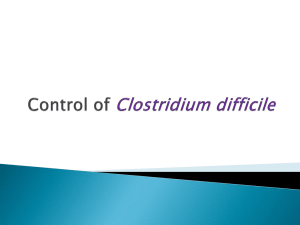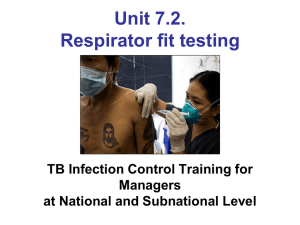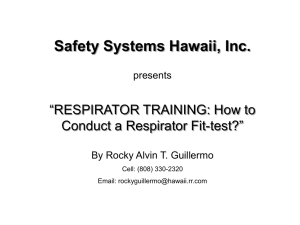Use of Personal Protective Equipment – Pandemic Influenza
advertisement
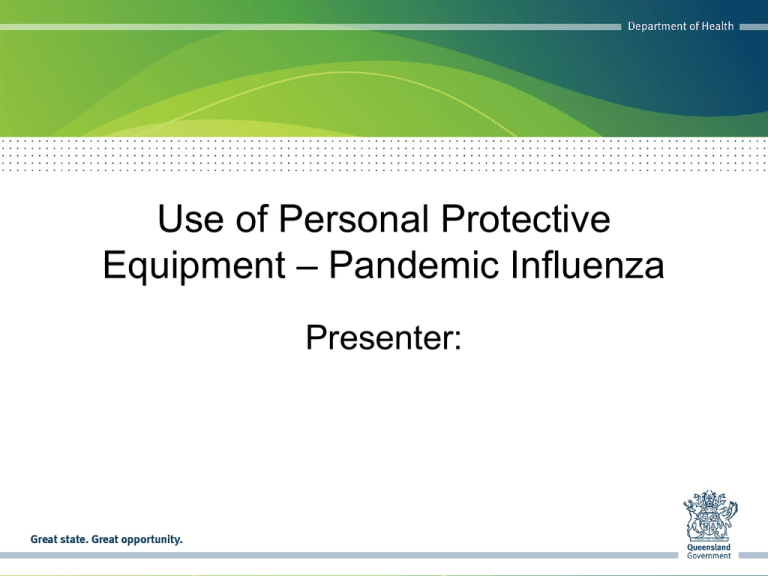
Use of Personal Protective Equipment – Pandemic Influenza Presenter: Types of PPE used for Pandemic Influenza • Gloves – protect hands • Gowns/aprons – protect skin and/or clothing • Masks and P2/N95 respirators– protect mouth/nose • P2/N95 Respirators – protect respiratory tract from airborne infectious agents • Protective eyewear – protect eyes • Face shields – protect face, mouth, nose, and eyes Key points about PPE • Follow a consistent sequence when donning and removing PPE • Ensure your PPE is fitted correctly to provide maximum protection • Take your time • Don’t touch your face/mask/eyewear when in the isolation area Key points about PPE • Don before contact with the patient, before entering the room • Use carefully – don’t spread contamination • Remove and discard carefully; remove P2/N95 respirator (if used) outside room • Immediately perform hand hygiene Sequence for Donning PPE 1. Perform hand hygiene 2. Gown 3. Mask (or P2/N95 respirator if aerosol generating procedures to be performed) 4. Perform fit check if P2/N95 respirator worn 5. Protective eyewear or face shield 6. Perform fit check if P2/N95 respirator worn 7. Gloves 8. Stop & check Step 1 - Perform Hand Hygiene • Washing hands with the use of a water and soap or a soap solution, either nonantimicrobial or antimicrobial OR • Applying a waterless antimicrobial hand rub to the surface of the hands (e.g. alcoholbased hand rub) • Refer to Hand Hygiene Australia for detailed instructions http://www.hha.org.au/home.aspx Step 2 – Don gown • • • • • Select appropriate type and size Opening is in the back Secure at neck and waist Ensure all clothing is covered If gown is too small, use two gowns – Gown #1 ties in front – Gown #2 ties in back • When non-impervious gowns being used, use a plastic apron over cloth gown Step 3 – Don mask • • • • Place over nose, mouth and chin Fit flexible nose piece over nose bridge Secure on head with ties or elastic Adjust to fit OR Step 3 – Don P2/N95 Respirator • A P2/N95 respirator should be worn whenever aerosol generating procedures are going to be performed • Select a suitable P2/N95 respirator • Ensure mask is not damaged in any way • Place over nose, mouth and chin • Follow the manufacturer’s instructions for fitting • Fit flexible nose piece over nose bridge • Secure on head with elastic • Adjust to fit • For detailed information on donning a P2/N95 mask, please refer to the presentation available at http://www.health.qld.gov.au/chrisp/resources/Fit_Ch eck.ppt Step 4 – Perform fit check (if wearing P2/N95 respirator) • Every time a P2/N95 respirator is worn a fit check must be performed: – Inhale – respirator should collapse slightly – Exhale – respirator should expand, check for air leakage around face • If mask does not collapse, expand or air leakage or fogging of glasses/protective eyewear is observed, check seals around bridge of nose and check if mask is crooked, bunched or folded. Then fit check mask again • For detailed information regarding fit checking P2/N95 masks, please refer to the presentation available at: http://www.health.qld.gov.au/chrisp/resources/Fit_Check.ppt and the factsheet available at: http://www.health.qld.gov.au/chrisp/resources/fit_check_factsheet.p df Step 5 – Don eye/face protection • Put on prescription eyewear (if worn) • Position protective eyewear over eyes/glasses and secure to the head using the arms of the eyewear • Adjust to fit comfortably Step 6 – Fit check mask (if wearing P2/N95 respirator) • If wearing a P2/N95 respirator re-fit check mask after donning protective eyewear • This will ensure protective eyewear is not affecting the fit of the mask • Inhale – respirator should collapse • Exhale – respirator should “puff out”, check for air leakage around face Step 7 – Don gloves • Select correct glove size • Put the first glove over your hand, then pull the end of the glove over the cuff of your gown • Repeat this for the other hand Step 8 – Stop & check • Do not touch your mask, protective eyewear or your face whilst in the isolation area • Ensure you stop and check the placement of your PPE before entering the isolation area • Ensure you are comfortable • Remove gloves if they become torn; perform hand hygiene before donning new gloves Safe removal of PPE • PPE may have been contaminated with respiratory droplets • Outside front of PPE most contaminated – Areas of PPE that have or are likely to have been in contact with body sites, materials, or environmental surfaces where the infectious organism may reside • Most likely time you could accidentally infect yourself • Minimise contact Safe removal of PPE • Remove PPE carefully – take your time • Immediately dispose or place PPE in receptacles for reprocessing • PPE removal principles and sequencing aims to protect the healthcare worker from contamination Where to remove PPE • Never remove mask inside the patient room • Remove gloves, protective eyewear and gown at doorway, before leaving patient room or in anteroom* • Remove mask/respirator outside room, after door has been closed* *Ensure that hand hygiene facilities are available at the point needed, e.g., sink or alcohol-based hand rub Sequence for Removing PPE 1. 2. 3. 4. 5. 6. 7. Gloves Hand hygiene Protective eyewear Gown Hand hygiene Mask Hand hygiene Step 1 – Remove gloves • Grasp cuff near wrist • Peel away from hand, turning glove inside-out • Hold in palm of gloved hand Step 1 – Remove gloves • Slide ungloved finger under the wrist of the remaining glove • Peel off from inside, creating a bag for both gloves • Discard Step 2 – Perform Hand Hygiene • Washing hands with the use of a water and soap or a soap solution, either non-antimicrobial or antimicrobial OR • Applying a waterless antimicrobial hand rub to the surface of the hands (e.g. alcohol-based hand rub) • Refer to Hand Hygiene Australia for detailed instructions http://www.hha.org.au/home.aspx Step 3 – Remove eye/face protection • Grasp arms of protective eyewear frames • Lift away from face • Place in designated receptacle for reprocessing or disposal Step 4 – Remove gown • • • • • Unfasten ties Peel gown away from neck and shoulder Turn contaminated outside toward the inside Fold or roll into a bundle Discard Step 5 – Perform Hand Hygiene • Washing hands with the use of a water and soap or a soap solution, either non-antimicrobial or antimicrobial OR • Applying a waterless antimicrobial hand rub to the surface of the hands (e.g. alcohol-based hand rub) • Refer to Hand Hygiene Australia for detailed instructions http://www.hha.org.au/home.aspx Step 6 – Remove mask • Untie the bottom, then top, tie • Remove from face – avoid touching the front • Discard • Do not reuse mask Step 6 – Remove P2/N95 Respirator • Never remove respirator inside the patient room • Avoid touching the front of the respirator • Remove by the straps • Remove down and away from face • Discard • Do not reuse respirator Step 7 – Perform Hand Hygiene • Washing hands with the use of a water and soap or a soap solution, either non-antimicrobial or antimicrobial OR • Applying a waterless antimicrobial hand rub to the surface of the hands (e.g. alcohol-based hand rub) • Refer to Hand Hygiene Australia for detailed instructions http://www.hha.org.au/home.aspx For Further Information • Queensland Health factsheet – P2/N95 Mask Fit Checking http://www.health.qld.gov.au/chrisp/resources/fit_check_factsheet.p df • Department of Health and Ageing – Pandemic Influenza Preparedness, Safe Use of Personal Protective Equipment (PPE) http://www.health.gov.au/internet/panflu/publishing.nsf/Content/safe use-dvd-1 – The World Health Organisation and 2014 AHMPPI assert that pandemic influenza patients should be managed using contact and droplet transmission-based precautions, however, the DoHA presentations do not currently reflect this – P2/N95 respirators are necessary for aerosol generating procedures – staff caring for closed circuit ventilator patients may wish to consider wearing P2/N95 respirators – Surgical masks provide sufficient protection for general care of pandemic influenza patients For Further Information • Centres for Disease Control (CDC) Protecting Healthcare Personnel http://www.cdc.gov/HAI/prevent/ppe.html
